
Dutch postcard by Takken / 't Sticht, no. 734. Photo: Metro-Goldwyn-Mayer. Leslie Caron and Gene Kelly in An American in Paris (Vincente Minnelli, 1951).
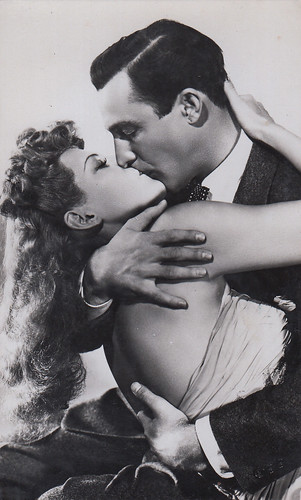
Spanish postcard by Archivo Bermejo. Rita Hayworth and Gene Kelly in Cover Girl (Charles Vidor, 1944). Collection: Marlene Pilaete.

French postcard, no. 1. Photo: Metro-Goldwyn-Mayer. Vera-Ellen and Gene Kelly in On the Town (Stanley Donen, Gene Kelly, 1949).

Dutch postcard. Photo: M.G.M. Gene Kelly and Cyd Charisse in Singin' in the Rain (Stanley Donen, Gene Kelly, 1952).
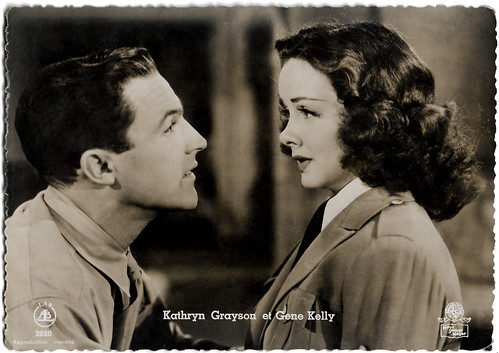
Belgian postcard by Les Editions d'Art L.A.B., Brussels, no. 2020. Photo: Metro-Goldwyn-Mayer. Kathryn Grayson and Gene Kelly in Thousands Cheer (George Sidney, 1943).
An accomplished sportsman and able to defend himself
Eugene Curran Kelly was born in 1912 in the East Liberty neighbourhood of Pittsburgh. He was the third son of James Patrick Joseph Kelly, a phonograph salesman, and his wife, Harriet Catherine Curran. By the time he decided to dance, he was an accomplished sportsman and able to defend himself. He attended St. Raphael Elementary School in the Morningside neighbourhood of Pittsburgh and graduated from Peabody High School at age 16. He entered Pennsylvania State College as a journalism major, but after the 1929 crash, he left school and found work to help his family financially.
He created dance routines with his younger brother Fred to earn prize money in local talent contests. They also performed in local nightclubs. In 1931, Kelly enrolled at the University of Pittsburgh to study economics. His family opened a dance studio in the Squirrel Hill neighbourhood of Pittsburgh.
In 1932, they renamed it the Gene Kelly Studio of the Dance and opened a second location in Johnstown, Pennsylvania, in 1933. Kelly served as a teacher at the studio during his undergraduate and law student years at Pitt. Kelly eventually decided to pursue a career as a dance teacher and full-time entertainer, so he dropped out of law school after two months.
In 1937, having successfully managed and developed the family's dance school business, he finally moved to New York City in search of work as a choreographer. His first Broadway assignment, in 1938, was as a dancer in Cole Porter's 'Leave It to Me!'
Kelly's first big breakthrough was in the Pulitzer Prize-winning 'The Time of Your Life' (1939), in which, for the first time on Broadway, he danced to his own choreography. In 1940, he got the lead role in Rodgers and Hart's 'Pal Joey', choreographed by Robert Alton. This role propelled him to stardom. Offers from Hollywood began to arrive.
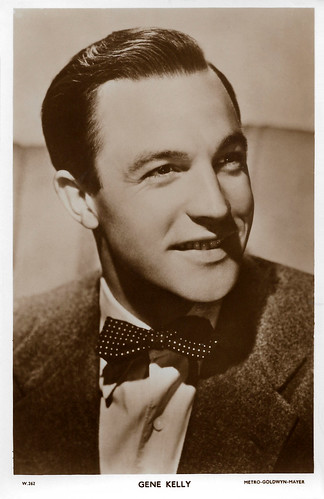
British postcard in the Picturegoer Series, London, no. W 262. Photo: Metro-Goldwyn-Mayer (M.G.M.).

Vintage card. Photo: Metro-Goldwyn-Mayer (M.G.M.).

Italian postcard in the Divi del Cinema series by Vetta Traldi, Milano, no. 102.
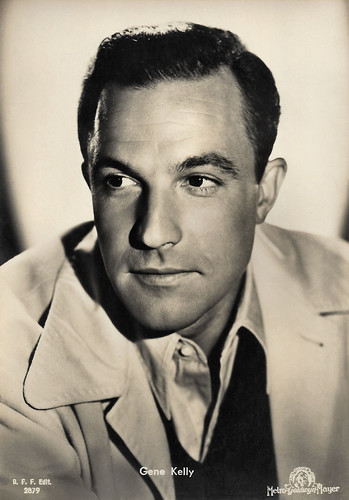
Italian postcard by B.F.F. Edit. (Casa Editr. Ballerini & Fratini, Firenze), no. 2879. Photo: Metro-Goldwyn-Mayer (M.G.M.).

French postcard by Edition P.I., Paris, no. 211, offered by Victoria, Brussels, no. 639. Photo: Metro-Goldwyn-Mayer, 1950.
The most inventive and effervescent musical
Metro-Goldwyn-Mayer was the largest and most powerful studio in Hollywood when Gene Kelly arrived in town in 1941. There he made his film debut with Judy Garland in For Me and My Gal (Busby Berkeley, 1942). The film was a production of the Arthur Freed unit at MGM and it was one of the big hits of the year.
The talent pool at MGM was especially large during World War II when Hollywood was a refuge for many musicians and others in the performing arts of Europe who were forced to flee the Nazis. Kelly's film debut was followed by Cole Porter's Du Barry Was a Lady (Roy Del Ruth, 1943) with Lucille Ball, the morale booster Thousands Cheer (George Sidney, 1943), Cover Girl (Charles Vidor, 1944) opposite Rita Hayworth, and Anchors Aweigh (George Sidney, 1945) with Frank Sinatra.
MGM gave him a free hand to devise a range of dance routines for the latter, including his duets with Sinatra and the celebrated animated dance with Jerry Mouse — the animation for which was supervised by William Hanna and Joseph Barbera. Anchors Aweigh became one of the most successful films of 1945 and Kelly was nominated for the Academy Award for Best Actor. In Ziegfeld Follies (1946), Kelly collaborated with Fred Astaire, for whom he had the greatest admiration, in 'The Babbitt and the Bromide' challenge dance routine. He co-starred with Judy Garland in The Pirate (Vincente Minnelli, 1948) which gave full rein to Kelly's athleticism. It features Kelly's work with the Nicholas Brothers — the leading black dancers of their day — in a virtuoso dance routine. Now regarded as a classic, the film was ahead of its time but flopped at the box office.
Kelly made his debut as a director with On the Town (Gene Kelly, 1949), for Arthur Freed. Stanley Donen, brought to Hollywood by Kelly to be his assistant choreographer, received co-director credit for On the Town. A breakthrough in the musical film genre, it has been described as "the most inventive and effervescent musical thus far produced in Hollywood." Two musicals secured Gene Kelly's reputation as a major figure in American musical film. First, he directed and starred in An American in Paris (Gene Kelly, 1951) with Leslie Caron. The highlight of the film is the seventeen-minute ballet sequence set to the title song written by George Gershwin and choreographed by Kelly. The sequence cost a half-million dollars (U.S.) to make in 1951 dollars.
Kelly's many innovations transformed the Hollywood musical, and he is credited with almost single-handedly making the ballet form commercially acceptable to film audiences. In 1952, he received an Academy Honorary Award for his career achievements, the same year An American in Paris won six Academy Awards, including Best Picture. Probably the most admired of all film musicals is his next film, Singin' in the Rain (1952). As co-director, lead star, and choreographer, Kelly was the central driving force and unforgettable is Kelly's celebrated and much-imitated solo dance routine to the title song. Dale O'Connor at IMDb: "Kelly was in the same league as Fred Astaire, but instead of a top hat and tails Kelly wore work clothes that went with his masculine, athletic dance style."

Dutch postcard by van Leer's Fotodrukindustrie N.V., Amsterdam, no. 351, no. 6. Photo: Metro Goldwyn Mayer (M.G.M.). June Allyson and Gene Kelly in The Three Musketeers (George Sidney, 1948), based on the novel by Alexandre Dumas.

Belgian postcard by Victoria Biscuits Chocolats, no. 4. Photo: M.G.M. Frank Morgan, Reginald Owen, Gene Kelly, Van Heflin, Gig Young, and Robert Coote in The Three Musketeers (George Sidney, 1948), based on the novel by Alexandre Dumas.
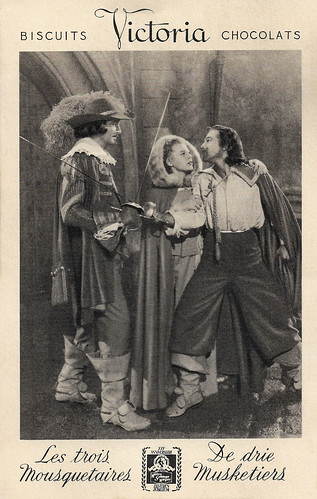
Belgian postcard by Victoria Biscuits Chocolats, no. 8. Photo: M.G.M. June Allyson and Gene Kelly in The Three Musketeers (George Sidney, 1948), based on the novel by Alexandre Dumas.
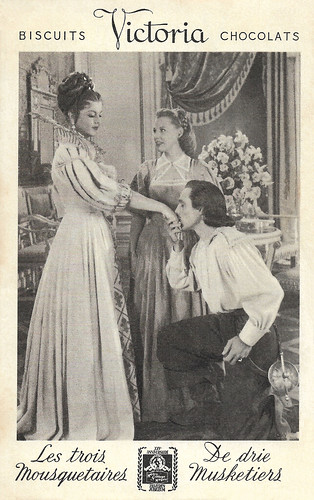
Belgian postcard by Victoria Biscuits Chocolats, no. 12. Photo: M.G.M. Angela Lansbury, June Allyson, and Gene Kelly in The Three Musketeers (George Sidney, 1948), based on the novel by Alexandre Dumas.

Belgian postcard by Victoria Biscuits Chocolats, no. 17. Photo: M.G.M. Lana Turner and Gene Kelly in The Three Musketeers (George Sidney, 1948), based on the novel by Alexandre Dumas.
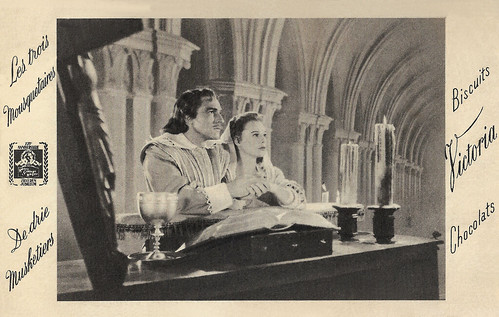
Belgian postcard by Victoria Biscuits Chocolats, no. 19. Photo: M.G.M. Gene Kelly and June Allyson in The Three Musketeers (George Sidney, 1948), based on the novel by Alexandre Dumas.

Dutch postcard by Foto Archief Film en Toneel, no. 3454. Photo: M.G.M. Van Heflin, Gene Kelly, Gig Young, and Robert Coote in The Three Musketeers (George Sidney, 1948), based on the novel by Alexandre Dumas.
The 15th greatest male screen legend of Classic Hollywood
Kelly continued his string of classic Hollywood musicals with Brigadoon (1954) with Cyd Charisse, and It's Always Fair Weather (1955), co-directed with Donen. The latter was a musical satire on television and advertising and includes his roller-skate dance routine to 'I Like Myself', and a dance trio with Michael Kidd and Dan Dailey that Kelly used to experiment with the widescreen possibilities of Cinemascope. Next followed Kelly's last musical film for MGM, Les Girls (1957), in which he partnered with a trio of leading ladies, Mitzi Gaynor, Kay Kendall, and Taina Elg. It, too, sold only a few movie tickets. He finally made for MGM The Happy Road (1957), set in his beloved France, his first foray into a new role as producer-director-actor. After leaving MGM, Kelly returned to stage work.
After musicals got out of fashion, Gene Kelly starred in two films outside the musical genre: Inherit the Wind (Stanley Kramer, 1960) with Spencer Tracy and Fredric March, and What a Way to Go! (1964). In 1967, he appeared in the French musical comedy Les Demoiselles de Rochefort/The Young Girls of Rochefort (Jacques Demy, 1967) opposite Catherine Deneuve. It was a box-office success in France and was nominated for Academy Awards for Best Music and Score of a Musical Picture.
Kelly directed films without a collaborator, including the bedroom-farce comedy A Guide for the Married Man (1967) starring Walter Matthau, and the musical Hello, Dolly! (1969) starring Barbra Streisand and Matthau. The latter was nominated for the Academy Award for Best Picture. He appeared as one of many special narrators in the surprise hit That's Entertainment! (Jack Haley Jr., 1974). The compilation film was released by Metro-Goldwyn-Mayer to celebrate the studio's 50th anniversary. The film turned the spotlight on MGM's legacy of musical films from the 1920s through the 1950s.
Kelly subsequently directed and co-starred with his friend Fred Astaire in the sequel That's Entertainment, Part II (Gene Kelly, 1976). It was a measure of his powers of persuasion that he managed to coax the 77-year-old Astaire — who had insisted that his contract rule out any dancing, having long since retired — into performing a series of song-and-dance duets, evoking a powerful nostalgia for the glory days of the American musical film. It was later followed by That's Dancing! (Jack Haley Jr., 1985), and That's Entertainment, Part III (Bud Friedgen, Michael J. Sheridan, 1994). Kelly received lifetime achievement awards in the Kennedy Center Honors (1982) and from the Screen Actors Guild and American Film Institute. In 1999, the American Film Institute also ranked him as the 15th greatest male screen legend of Classic Hollywood Cinema.
Gene Kelly passed away in 1996 at the age of 83 in Beverly Hills, California, U.S. His final film project was the animated film Cats Don't Dance, not released until 1997, on which Kelly acted as an uncredited choreographic consultant. It was dedicated to his memory. Gene Kelly was married three times: to actress Betsy Blair (1941-1957), Jeanne Coyne (1960- her death in 1973), and Patricia Ward (1990- his death in 1996).

Italian postcard by Rotalfoto, Milano, no. 395.
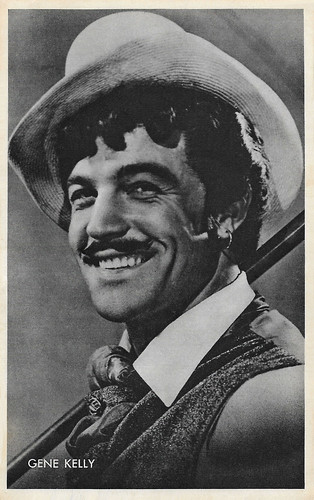
Belgian collectors card by Kwatta, Bois d'Haine, no. C. 153. Photo: M.G.M. Gene Kelly in The Pirate (Vincente Minnelli, 1948).
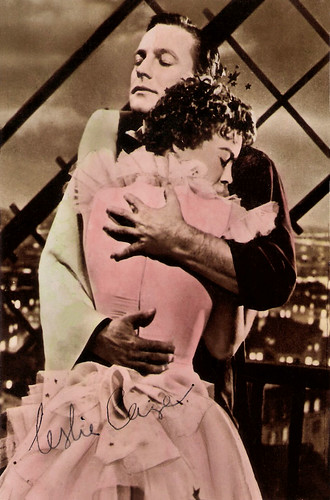
Vintage autograph card. Photo: Leslie Caron and Gene Kelly in An American in Paris (Vincente Minnelli, 1951).

Big programme card by Cineteca Bologna for Il Cinema Ritrovato, XXXVI edizione, Selezione Cinema Ritrovato Young, 2 July 2022. Cyd Charisse and Gene Kelly in Singin' in the Rain (Stanley Donen, Gene Kelly, 1952).

American postcard by Fotofolio, no. 2859. Photo: Milton H. Greene. Caption: Gene Kelly, Los Angeles, 1959. Gene Kelly in The Happy Road (Gene Kelly, 1957).

French postcard in the Entr'acte series by Éditions Asphodèle, Mâcon, no. 005/13. Collection: B. Courtel / D.R. Louis Armstrong, Barbra Streisand, and Gene Kelly on the set of Hello Dolly! (Gene Kelly, 1969). Caption: A moment of pause for Gene Kelly and his stars Barbra Streisand and Louis Armstrong.
Sources: Dale O'Connor (IMDb), Wikipedia, and IMDb.
This post was last updated on 13 December 2024.
No comments:
Post a Comment